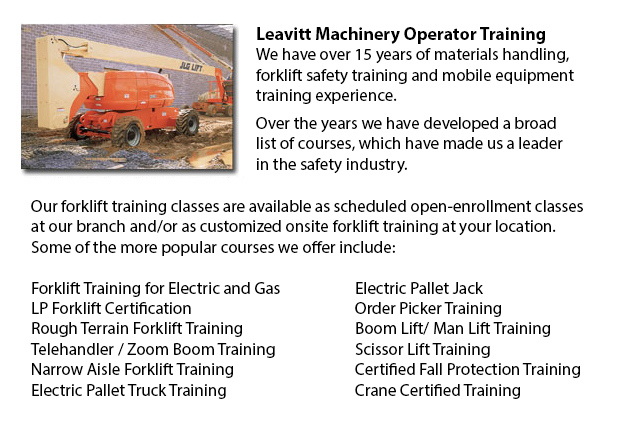
Saskatoon Aerial Lift Safety Training - Every year, there are around 26 construction deaths attributed to the utilization of aerial lifts. Nearly all of the craftsmen killed are laborers, electrical workers, painters, ironworkers or carpenters. Most deaths are caused by tip-overs, electrocutions and falls. The greatest hazard is from boom-supported lifts, such as cherry pickers and bucket trucks. Nearly all deaths are connected to this particular type of lift, with the rest involving scissor lifts. Other dangers comprise being struck by falling things, being thrown out of a bucket, and being caught between the lift bucket or guardrail and an object, such as a joist or steel beam.
The safe operation of an aerial lift needs an inspection on the following items before using the device: emergency and operating controls, personal fall protection gear, safety devices, and wheels and tires. Check for possible leaks in the air, fuel-system, hydraulic fluid. Check the device for loose or missing parts.
The area where the device will be used should be thoroughly checked for possible dangers, like for instance holes, bumps, drop-offs and debris. Overhead power lines should be avoided or closely monitored. It is suggested that aerial lift devices be utilized on level, stable surfaces. Don't work on steep slopes which go beyond slope limitations specified by the manufacturer. Even on a level slope, outriggers, brakes and wheel chocks should be set.
Businesses must provide their aerial lift operators with the right guidebooks. Mechanics and operators should be trained by a certified person experienced with the relevant aerial lift model.
Aerial Lift Safety Guidelines:
o Before operating, close lift platform chains and doors.
o Do not climb on or lean over guardrails. Stand on the platform or floor of the bucket.
o Make use of the provided manufacturer's load-capacity limits.
o When working near traffic, use proper work-zone warnings, such as signs and cones.
If correct procedures are followed, electrocutions are avoidable. Stay at least ten feet away from whichever power lines and licensed electricians should insulate and/or de-energize power lines. Workers need to use personal protective equipment and tools, like insulated bucket. Nonetheless, a bucket that is insulated does not protect from electrocution if, for example, the worker touches another wire providing a path to the ground.
When inside the bucket, workers must prevent possible falls by securing themselves to the guardrails by using a positioning device or a full-body harness. If there is an anchorage in the bucket, a positioning belt with a short lanyard is acceptable.
By following the manufacturer's directions, tip-overs could be avoided. Never drive the lift platform whilst it is elevated, unless the manufacturer specifies otherwise. Follow the device's vertical and horizontal reach limitations, and never exceed the specified load-capacity.
-
Saskatoon Telehandler License
Saskatoon Telehandler License - The telescopic handler or telehandler is a frequently utilized machine in agricultural and industrial applications. This particular equipment is similar in appearance to a forklift and even functions in a similar way,... More -
Saskatoon Zoom Boom Ticket
Saskatoon Zoom Boom Ticket - Zoom Boom Training focuses on correctly training prospective operators on variable reach forklifts. The training objectives consist of gaining the knowledge of the machine's physics and to define the job of the operator.... More -
Saskatoon Forklift Operator Training
Saskatoon Forklift Operator Training - In North America, lift truck operator training is needed in order to prevent workplace injuries and accidents. Particular lift truck training will be provided to offer forklift operators driver training. The saf... More -
Saskatoon Forklift Certification Schools
Saskatoon Forklift Certification Schools - Forklift Certification is mandatory in North America. Hence, forklift training programs are essential both for businesses and for individuals seeking jobs in industries as forklift operators. Forklift traini... More -
Saskatoon Telehandler Training Courses
Saskatoon Telehandler Training Courses - Employers are responsible for making certain that their operating personnel and supervisors are trained to work competently utilizing telehandler machines. The competence level of staff must be assessed. If de... More -
Saskatoon Boom Lift Training
Saskatoon Boom Lift Training - Aerial platforms or likewise known as elevated work platforms are devices that enable workers to perform tasks and duties at elevated heights that will not be otherwise accessible. There are many aerial lifts available... More -
Crane / Overhead Crane / Self-Erect Crane / Truck Mounted Crane / Hydraulic Cranes Training in Saskatoon
Overhead cranes are likewise referred to as bridge cranes. They are a type of crane which comprises a line and hook device that runs along a horizontal beam which runs along two widely separated rails. Several overhead cranes can be found within a lo... More -
Saskatoon Heavy Equipment Training Programs
Saskatoon Heavy Equipment Training Programs - At any given construction site, there are usually different types of machinery which are ready to be used. These light and heavy machinery require both operators to run them and mechanics to fix them. Tra... More

Forklift Certification Saskatoon
TOLL FREE: 1-888-254-6157
Saskatoon, Saskatchewan
forkliftcertificationsaskatoon.com
Email Us
About Us


